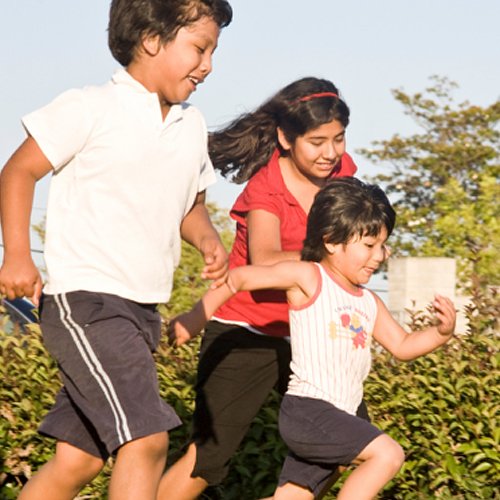
Changing the Story About Park and Green Space Equity: A Messaging Guide for Advocates
-
Focus Areas
Capacity Building & Leadership, Environmental Health, Healthy Communities -
Expertise
Media Advocacy & Communications, Public Policy Advocacy -
Programs
Berkeley Media Studies Group

How we talk about parks and green spaces can help—or hinder—communities across the country in their work toward their vision of transforming the landscape and ensuring an equitable distribution of parks and green space.
To bring park equity to scale, we need to center narratives led by those who are rooted in communities where park inequities are profound.
What is the dominant narrative about parks and green space? And how different is that dominant narrative from the narrative we want to see? As communities across the country are working to ensure that parks and green space are accessible to everyone, a new messaging guide, developed by PHI’s Berkeley Media Studies Group with support from the People, Parks, and Power (P3) initiative, can equip advocates and organizers with the communication tools they need to make an effective case to decision-makers and center those with the most at stake.
This guide is a tool to help communities, organizers, and advocates build narrative power: the ability for a group to have its story be the story. Building narrative power is a long-term goal created in the present, campaign by campaign, organizer by organizer, community by community.
see the complete guideDeveloping strategy
Underlying any strategic message about green space and park equity is the reason we want a message in the first place: we want a world where every community can breathe free and enjoy parks and green space. That means that before crafting a message, you need to have an overall strategy that specifies the immediate issue you want to address, clarifies the solution that you will advocate for, identifies who has the power to make the change, and names the allies who will help make your case.
What’s our entry point?
These starting points may be interconnected: the same group might champion park and green space equity because its members are committed to conservation for its own sake and because they value the health benefits and community connections a park can foster. In short, parks and green space can be linked to many other efforts to create and maintain communities that transform the legacies of slavery and colonialism and ensure equity, justice, and liberation for everyone.
What’s our policy approach?
How each community will arrive at their change will differ depending on the circumstances and goals, so “how” we achieve will likely be a combination of organizing and advocacy to pressure decision makers to enact equitable policies.
What do we need to know?
You can establish your overall strategy by asking five questions:
- What is the problem?
- What is the solution?
- Who has the power to make change?
- Who are our partners?
- What will it take to influence decision-makers?
Understanding narratives about green spaces and parks
Even the most thoughtfully crafted strategy—or message—won’t inform people, let alone accelerate change, unless it reaches your audience. Building narrative power is a complex process that involves significant and sustained work across many sectors and institutions. One place where stories are shared — and narratives are reinforced—is news coverage.
Crafting your message
This section reviews components of effective messages that can help audiences understand why parks and green spaces are a “need to have,” not just a “nice to have,” and illustrate the solutions that can help us achieve park and green space equity—including procedural, structural, and distributional equity. Based on our research (including in-depth conversations and interviews with equity advocates from around the country), and decades of experience supporting advocates in crafting and delivering strategic messages, we know that there are several core components to effective messages about park and green space equity.
Getting attention
There are many ways for community leaders and park and green space equity advocates to enter and influence the media narrative around parks and green space. Done thoughtfully, attracting news attention can elevate community voices, invite others to the fight to build power, and elevate solutions — especially those we are seeking in the near term to address procedural, distributional, and structural equity around parks and green space.
Conclusion
No matter why you care about parks, we hope the communication tools in this guide will help you advance your equity goals. Be sure to use the layers of strategy to clarify your vision before you begin, and remember that when you craft messages, metaphors that evoke breathing can help give life to your messages and help your audience see and even feel themselves in your words. As you do the work, take a breath, look around and recognize the incredible strides you and other advocates have already made in advancing park and green space equity.
If we are able to tell the stories that need to be told in a way that people can hear them, we will be creating a more equitable future where people can connect with each other, enjoy nature and good health, and be liberated from historic inequities to exhale and finally be able to breathe freely.

Learn more: Preparing Community-Based Organizations with Media Advocacy Skills to Advance Green Space Equity
Many communities lack access to adequate green spaces, due to historical and ongoing racist and exclusionary practices such as segregation and redlining. Through the People, Parks and Power (P3) project, PHI’s Berkeley Media Studies Group (BMSG) is partnering with local advocates of color and community-based organizations to develop strategic communications and messaging tools they need to promote green space equity in communities across the country
Originally published by Berkeley Media Studies Group
Work With Us
You change the world. We do the rest. Explore fiscal sponsorship at PHI.
Support Us
Together, we can accelerate our response to public health’s most critical issues.
Find Employment
Begin your career at the Public Health Institute.


